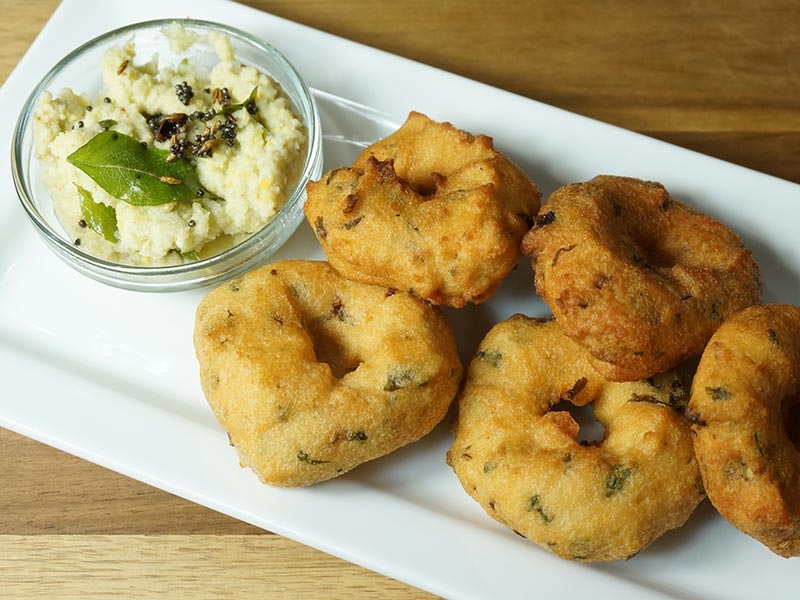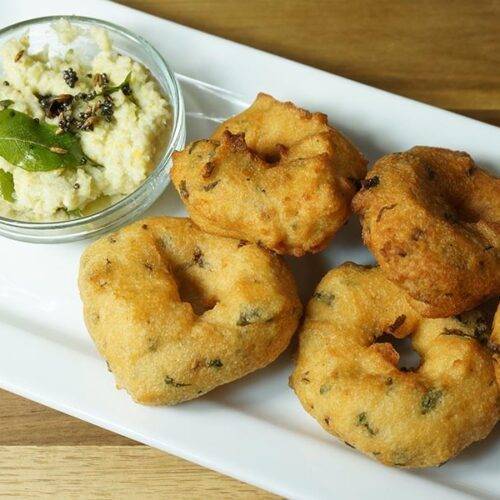Medu Vada is commonly enjoyed with coconut chutney or sambar, enhancing its flavor profile and making it a popular choice for those seeking gluten-free and vegan snack options. Medu Vada is a popular South Indian snack known for its crispy exterior and soft interior texture. Originating from the state of Tamil Nadu, it has gained widespread popularity across India and beyond. This medu vada recipe offers a step-by-step guide on how to make this delectable treat right in your kitchen.
How to Make Medu Vada: Step-by-Step Recipe
Preparing the Batter
To start making medu vada, you’ll need to prepare the batter first. Begin by soaking urad dal in water for at least 4-5 hours or preferably overnight. The soaked dal should be soft enough to easily break when pressed between your fingers. Once soaked, drain the water and transfer the dal to a blender. Grind it to a smooth paste, adding minimal water as needed. The consistency should be thick, similar to that of a pancake batter. This step is crucial in achieving the perfect texture for your medu vada.
Shaping the Vadas
Once the batter is ready, transfer it to a mixing bowl. Add finely chopped green chilies, ginger, curry leaves, cumin seeds, asafoetida, and salt to taste. Mix all the ingredients thoroughly to ensure an even distribution of flavors. Now, heat oil in a deep frying pan or kadhai on medium heat. To shape the vadas, wet your palms with water to prevent sticking. Take a small portion of the batter and flatten it slightly to form a disc shape with a hole in the center, resembling a donut. Carefully slide the shaped vada into the hot oil and fry until golden brown and crispy on both sides. Repeat the process with the remaining batter, frying a few vadas at a time to avoid overcrowding the pan.
Frying to Perfection
Achieving the perfect medu vada requires frying them to crispy perfection. Make sure the oil is adequately heated before adding the vadas to ensure they cook evenly and develop a crunchy exterior. It’s essential to maintain the oil at a consistent temperature throughout the frying process. Avoid overcrowding the pan, as this can lower the oil temperature and result in soggy vadas. Fry the vadas in small batches, flipping them occasionally to ensure uniform browning on all sides. Once done, remove the vadas from the oil using a slotted spoon and drain the excess oil on paper towels.
Serving Suggestions
Medu vada is best enjoyed hot and crispy, served with coconut chutney and sambar. You can also pair it with a tangy tomato chutney or spicy mint chutney for added flavor. Some prefer to enjoy medu vada with a cup of hot filter coffee, making it a perfect breakfast or evening snack option. Experiment with different dipping sauces and accompaniments to find your favorite combination.
Tips for Making Perfect Medu Vada
Ensure the urad dal is soaked well to achieve a smooth batter texture. Maintain the oil temperature while frying to achieve crispy vadas. Wet your palms with water to prevent the batter from sticking while shaping the vadas. Add chopped green chilies and ginger for an extra kick of flavor. Serve medu vada hot for the best taste and texture.
Variations of Medu Vada
While the traditional medu vada recipe calls for basic ingredients like urad dal, spices, and herbs, you can experiment with variations to suit your taste preferences. Some popular variations include:
Masala Medu Vada: Add coriander leaves and grated carrots to the batter for an extra burst of flavor. Rava Medu Vada: Mix semolina (rava) with the urad dal batter to add a crunchy texture to the vadas. Vegetable Medu Vada: Incorporate grated vegetables like carrots, cabbage, and spinach into the batter for a nutritious twist. Cheese Medu Vada: Stuff the vadas with a cheesy filling or sprinkle grated cheese on top before frying for a gooey, indulgent treat.
Benefits of Medu Vada
Medu vada is not only delicious but also offers several health benefits when consumed in moderation. Here are some of the benefits:
Rich in Protein: Urad dal, the main ingredient in medu vada, is a good source of protein, essential for muscle repair and growth. Nutrient-Dense: It contains essential nutrients like iron, magnesium, and potassium, which are vital for overall health and well-being. Gluten-Free: Since medu vada is made from urad dal, it is naturally gluten-free, making it suitable for individuals with gluten sensitivities or celiac disease. Good Source of Fiber: Including medu vada in your diet can help improve digestion and promote gut health due to its fiber content. Energizing Snack: It provides a quick energy boost, making it an ideal snack option for busy days or post-workout refueling.
Q: Can I make the batter ahead of time?
A: Yes, you can soak the urad dal and grind the batter ahead of time. Store it in the refrigerator for up to 1-2 days and fry the vadas when ready to serve.
Q: Can I freeze the vadas?
A: While it’s best to consume medu vada fresh for optimal taste and texture, you can freeze the shaped vadas and fry them directly from frozen when needed. However, freshly fried vadas are recommended for the best flavor.
Q: Can I bake instead of frying?
A: While traditional medu vada is deep-fried for that crispy texture, you can try baking them in a preheated oven at 375°F (190°C) for 20-25 minutes or until golden brown for a healthier alternative.
Q: Can I use split urad dal instead of whole urad dal?
A: Yes, you can use split urad dal (white or black) to make medu vada. However, the texture may vary slightly compared to using whole urad dal.
Q: Can I make gluten-free medu vada?
A: Yes, medu vada is naturally gluten-free since it’s made from urad dal. Just ensure that all ingredients used are gluten-free, especially if adding any additional flavorings or seasonings. Explore more Indian recipes on Manjula’s Kitchen:
Paneer Tikka Masala Vegetable Biryani Palak Paneer Aloo Paratha Mango Lassi
In conclusion, medu vada is a versatile and flavorful snack that can be enjoyed on its own or paired with a variety of chutneys and dips. With this detailed recipe and helpful tips, you can recreate this South Indian delicacy at home and impress your family and friends with your culinary skills. So, roll up your sleeves, gather your ingredients, and get ready to savor the crispy goodness of homemade medu vada!
Hi, can we whip the batter with an electric whisk?
yes
Hello Manjula, I like your recipe informative and straightforward. I just did differently; instead of my hand beating the mixture, I used a whisk and added a pinch of baking soda.
Sounds good
Hi mam, i cant get black urid dal in nearby stores, can i use normal white urid dal? What it will taste good?
Shiv, Recipe ask for normal white urid dal
Hello manjula I have a doubt. My vada blasted like a bomb today. Can I know the reason you discover happened
Krish I don’t have a answer, I hear that often and once I have experienced,
If you grind the urad to fine it will burst so you can add 2 teaspoons of rava or Grind the dal little corse.
Had u added anything else in the wada? Once I had added 2 tbps of corn flour to the batter as it had become a little loose and the WADA had blasted. Not a drop of oil was left in the kadhai.
Hi I tried medu vada it was very soft , but excess oil remains what to do now please suggest
Thanks manjula ji ….ur website is very helpful ..I always look for ur website only whenever I need to find any new recipe.. Keep posting new recipes …thanks a lot
shikha, Thank you
Manjulaji today I seen your website. It has very good and healthy delirious recipes. I like them. Keep sharing them Thank you…
heĺlo mam can’t v soak urad daal for a night
I have tried making wada many time It’s always crispy from outside n v hard from inside. Plss help
Roopa, may be the batter was too thick, heat could be high or needed to whip the batter little bit.
Can onions also be used ?
Hi I tried making mendu wada from readymade batter from outside, but they turned to be very hard. Should I add little hot oil to batter for making soft menduwadas please help.
Purvi, Ready made batter should have the directions how to make, I have never used the oil in the batter.
Hi there. Can i use urid dhall flour. If using flour is it still the same measurement ie 1 cup?
sakeenah, flour will not work
Love this site. looking forward to work wit ur firm in future. AGAPE
Hello mam. I tried them so many times they taste good but not soft. I want to know how to check the right consistency.. Sometimes they blast during cooking. Please help me. My daughter loves vada a lot.
Parul, if batter is too thick that can make vadas hard also need to whip the batter
Fantastic website and recipes.
I can’t get black urid dal from my local shops. Can I use either black urid beans or white urid dal instead? Would either be a good substitute?
John, The main ingredient for medu vada is urid dal, you can make them using different beand but it will not be medu vada and still will taste great.
i like this recipe
nice………… and look very tasty.
Mam, you can add a spoon or two of rice flour which will help the vadas to remain crisp for some more time.. and people do add ginger which is chopped into small pieces which adds a very much good flavour to these vadas.
Nandhini, Thanks for the suggestion, I will try next time when I make Medu Vada.
mam,thanks for the recipe.. its not the coriander seeds that are used. it’s whole black pepper oly.. using coriander seeds spoils the actual taste of medu vadai.. and also the curry leaves not the coriander leaves..
No its not coriander seeds or black pepper but instead whole cumin seeds and curry leaves are used.
Password
Remember Me

